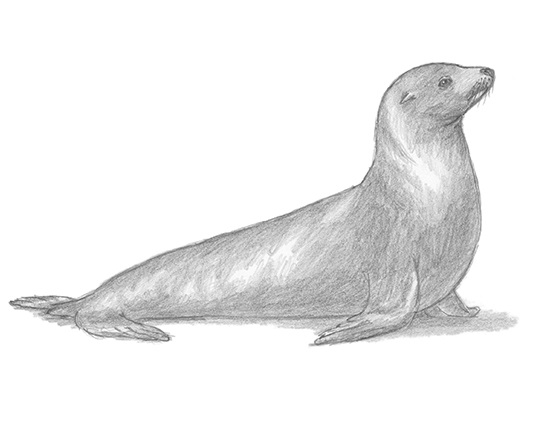


How to Draw a Seal
Please PAUSE the video after each step to draw at your own pace.
For the first few steps, don’t press down too hard with your pencil. Use light, smooth strokes to begin.
Step 1: Draw a circle as a guide for the front part of the seal’s body. It doesn’t have to be perfect. It’s just a guide.
Step 2: Draw a pointy triangle-like shape on the left as a guide for the back portion of the seal’s body. Just draw two lines that start at the top and bottom of the circle and come to a point on the left. The bottom line should be pretty flat.
Step 3: Draw another circle on the upper right side as a guide for the seal’s head. Don’t place the circle too high up or your seal will end up with a neck that’s too long.
Step 4: Draw a U-shaped arc on the upper right side of the head as a guide for the seal’s muzzle.
Step 5: Draw two lines that connect the seal’s head and body to create the neck. The lines should dip in near the middle for a wavy look.
Step 6: Draw three triangle-like shapes under the seal’s body as guides for the flippers. The first shape should be long, the second should be short, and the last shape at the bend should be in between both sizes.
That’s it for the initial sketch! From this point on, press harder with your pencil to get a more defined sketch.
Step 7: Draw the eye on the upper right portion inside the seal’s head. The shape of the eye is similar to a football. Inside the eye, draw a circle for the actual eyeball. Draw a tiny circle to represent glare. Draw a slightly bigger circle and shade it in for the pupil. Shade in the rest of the eye using a lighter value than the pupil. Draw a few extra lines around the eye for wrinkles.
Step 8: Draw the seal’s nose on the tip of the muzzle. The shape of the nose is similar to a very thin triangle. Draw a shaded oval in the middle for the nostril.
Step 9: Use the initial arc as a guide to draw the rest of the seal’s muzzle. Shape the top and bottom of the muzzle as you follow the path of the arc and add a line near the bottom for the mouth.
Step 10: Draw the whiskers in the muzzle. First draw a few tiny dots as the base of the whiskers. Then add the whiskers at each dot using quick, long strokes.
Step 11: Draw the samll ear on the upper left side of the seal’s head.
Step 12: Use the initial circle as a guide to draw the rest of the head. Make the head a bit thinner and add a few lines at the bottom for folds of skin.
Step 13: Using the shapes in front as guides, draw the seal’s front flippers. The base of the flipper starts inside the original circle. Bend the shape of the flipper as you darken the lines. Draw a few lines at the end of the flipper for extra detail. Use the other shape to draw the flipper on the other side. The tip of the flipper isn’t visible because of the perspective.
Step 14: Use the shape on the left as a guide to draw the hind flippers. Bend the shape more as you darken the lines and add a few more lines at the end for detail. Bend the shape more as you darken the lines and add a few more lines at the end for detail. Draw the other flipper on the other side. The body will be in front of most of it, so only draw the tip.
Step 15: Draw the rest of the seal’s body by using the remaining lines as guides. Draw a small nub on the left for the tail as you darken the guide lines. Give the body an extra bump near the tail for a curvier look. Make the body a little thicker throughout for a more round and organic feel.
Step 16 (optional): You can stop here for a sketchy look or erase as much as you can of the initial guide lines for a cleaner look. Don’t worry about erasing all of the guides. It’s okay to leave some behind. Also re-draw any final sketch lines that you may have accidentally erased.
Step 17 (optional): Add some shading to your seal drawing to give it more dimension and volume. Pick the direction of the light source when shading so that the shadows are consistent with it.
Step 18 (optional): Add a bit of a cast shadow underneath. This helps ground the seal so it doesn’t appear to be floating.
Step 19 (optional): You can add more value throughout your drawing for extra detail. Vary the pressure on your pencil to get different degrees of tonal value. You can leave a portion of the body in the middle unshaded to live the seal a shiny, wet look. Try to add the value smoothly throughout the body for a sleek feel instead of a rough-textured look. It’s always a good idea to use reference to be as accurate as possible.


 (2 votes, average: 4.50 out of 5)
(2 votes, average: 4.50 out of 5)